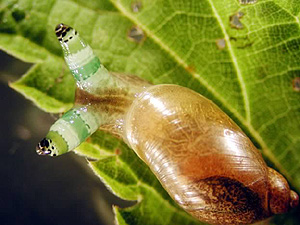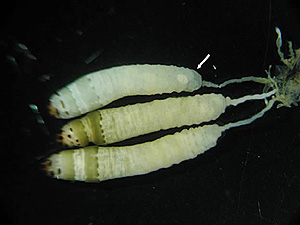
Amber snails [RN].
 Amber snails [RN]. |
Sometimes amber snails (Succinea or Oxyloma) can be found, that attract attention by their largely swollen tentacles, laterally striped by pulsating rings. This phenomenon is because of an infection of the snail by a parasitic distome, Leucochloridium paradoxum, the green-banded broodsac.
 Leucochloridium spec. Picture: Christian Fuchs [1]. |
|
 Sporocyste tubes of Leucochloridium dissected from the ten- tacles of an amber snail. Picture: Christian Fuchs [1]. |
This parasitic worm belongs to the group of flatworms (Plathelminthes), and among these to the distomes (Trematoda, Digenea).
Similar to other flatworms, the development of a distome also passes a change of generations, where one generation infects a snail as intermediate host, and one generation infects a warm-blooded animal, in this case a bird, as final host.
The bird, with its droppings, spreads the distome's eggs, of which hatch the ciliated larvae or miracidia. Those then infect a snail living near the water.
Out of the snail's digestive system, the miracidia wander into the main digestive gland and change into the next larval stage, the cercariae. Those gather in sporocyste, long tubes, that extend into the snail's tentacles. Several hundred cercariae can be contained in one of those sporocyste tubes.
The sporocyste tube is what can be seen pulsating in the snail's tentacles. The tentacles, swollen by the sporocystes, cannot be withdrawn by the snail, but instead attract a bird by their eye-catching colouring and movement. The bird rips off the snail's tentacle, and as a reward, is infected by the cercariae within.
In the bird's digestive system adult distomes evolve from the cercariae, that reproduce sexually and lay eggs, which are then spread by the bird's droppings. The circle is closed.
The amber snail distome certainly is one of the less harmful trematodes, unless seen from the perspective of an amber snail, that is. But by the same system, much more harmful trematode parasites develop, that may well mean a harm to man or his animals, as we describe in the other pages in this chapter.